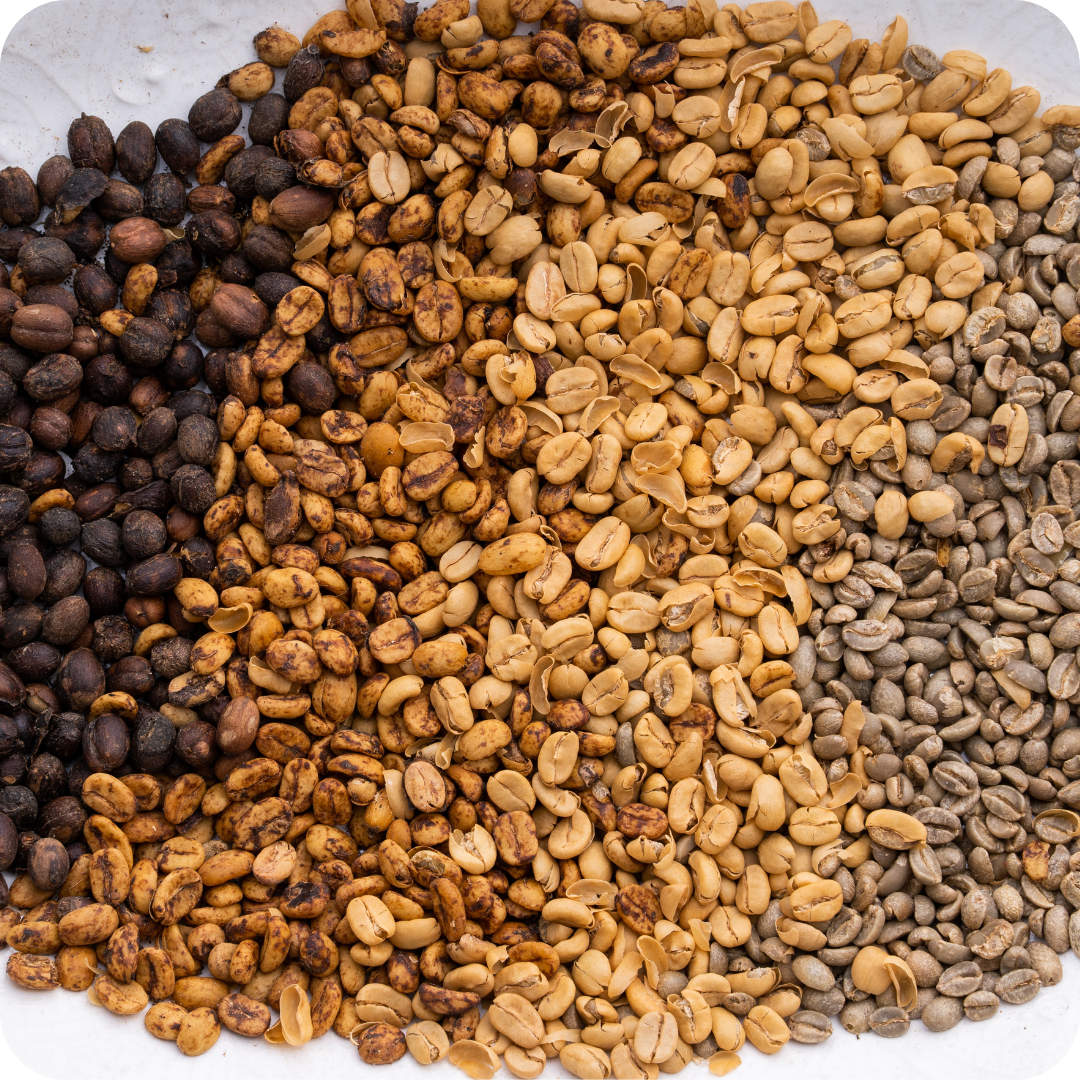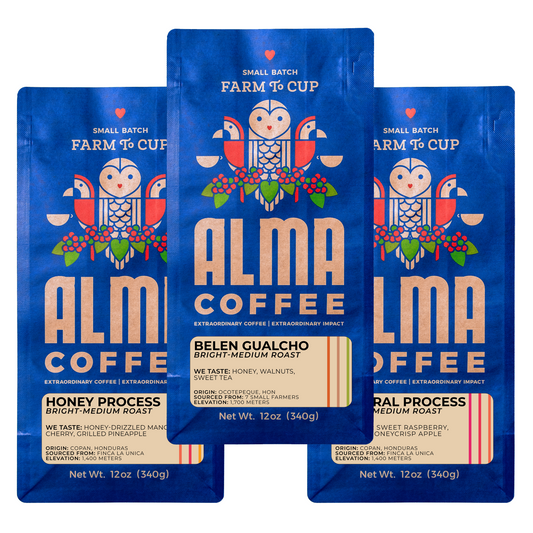
Does Coffee Freshness Really Matter?
Share

Exactly how important is the freshness of coffee to final flavor?
Unlike other perishable grocery store items with clear expiration dates printed on the back, the concept of coffee getting “bad” draws mixed reactions across the spectrum of coffee enthusiasts and casual drinkers.
Without becoming moldy, soft, or changing colors in your kitchen pantry because you forgot it’s been hiding behind a few boxes of mac n cheese the last year, how is anyone supposed to know when their favorite coffee is “bad” beyond the point of being drinkable?
Even though there is an active debate amongst coffee enthusiasts concerning the shelf life of roasted coffee and how to keep beans optimally tasty for as long as possible, we didn’t want to write a blog that only added to the confusion that already exists in coffee culture.
Instead, we think it’s better to provide evidence-based answers to a coffee questions just about as old as the coffee bean: does coffee freshness really matter?
So, go ahead and brew up your favorite roast, kick back, and get ready to learn more about the actual science behind coffee freshness, why factoring in the roast date of your favorite bean actually matters, and how you can learn to keep your favorite coffee fresher for longer!
Skip ahead now or keep scrolling to read the full "Does Coffee Freshness Matter?" blog post!
💌 Subscribe 💌
Our email newsletter isn't your typical marketing ploy. Sign up now and get notified when our weekly blog posts publish, new coffee roasts drop, and other exciting Alma Coffee promos!
Does coffee actually go "bad" or does it just lose flavor?
Before we dive further into a scientific explanation of the question posed above, we want to give a quick answer to those that surfed the web looking for something short and sweet…
Yes: coffee eventually goes “bad” beyond the point of consumption AND loses flavor over time, but these two natural phenomena are typically viewed as separate but interconnected occurrences in the life of a roasted coffee bean, with flavor loss being the first sign that coffee is beginning to go “bad.”

Like any perishable food item, coffee will inevitably go “bad” at some point—i.e., complete loss of flavor, becoming ultra-acidic, and/or forming toxic mold —in the same way that those bananas you bought two days ago are already beginning to show signs of rot.
Long before getting to the point of being “bad,” a roasted coffee bean begins losing natural flavor notes specific to origin the moment it exits a coffee roaster, and, depending on the bean, roast profile, and storage method, roasted coffee has approximately a 2-to-3-month shelf life before anyone might notice anything wrong in the flavor department.
We’ll keep digging deeper into why this degradation of flavor happens the way it does in the next section, but for those that have ever wanted a simplified way of understanding the shelf life of bagged coffee might find the infographic we made (below) for our own roasted beans helpful:

The science behind stale coffee
After dropping out of a roaster and into a cooling bay, a chemical reaction virtually unnoticeable to the human eye begins occurring inside of a coffee bean.
While temperatures rise throughout the roasting process, a combination of natural gasses already present within coffee’s molecular structure begin heating, rapidly expanding, and subsequently escaping from the organic structure of a bean.

This release of gas—primarily carbon dioxide (CO2)—is known as “degassing” in the coffee world, and although degassing is a natural, somewhat unavoidable byproduct of the coffee roasting process, it also helps to prevent oxygen from accelerating the natural deterioration of a bean.
When natural gasses finally release from within a bean after the 2 to 3 month mark, a combination of elemental exposure to oxygen, sunlight, and/or moisture inevitably tear apart the organic compounds within a coffee bean like they would any other decaying piece of matter.
This natural process of decay usually results in loss of flavor and increased acidity when you brew up a cup of old coffee, slowly accelerating in intensity the longer a bean goes without fully extracting into water.

Depending on the bean itself and/or how light or dark that bean is roasted usually determines the amount of time it takes for degassing to naturally conclude after roasting (which we’ve covered in detail in another blog), and this timeline also determines how long your coffee is going to stay tasty enough to brew before natural decay takes over.
Most of the degassing that could noticeably affect the flavor of a bean occurs immediately after roasting in the first few days of coffee’s shelf life (up to 40% in most cases, according to the SCA), meaning you shouldn’t worry about this chemical process affecting the flavor of freshly roasted coffee for too long during what roasters refer to as the “resting” period of a bean’s life.
Instead, degassing becomes critically important to the freshness of coffee between the time of a roasted bean’s “resting” period and the final release of internal gasses from within the bean, which is commonly referred to as the “freshness window” or “optimal freshness” of roasted coffee and gets to the heart of answering this specific blog post’s root question: does the coffee “freshness window” matter?
The "freshness window" of roasted coffee and why it matters...
Okay, so we’ve covered a few things up to this point in the blog that are important to understand moving forward:
1. Coffee will eventually begin losing flavor and go “bad” due oxidation and elemental exposure
2. A chemical release of gas called “degassing” helps prevent natural decay and preserve flavor notes specific to origin up to 2 or 3 months after roast, which is often referred to as the “freshness window” of roasted coffee.
During the “freshness window” of a coffee bean’s shelf life, everything you love about a particular roast—from the natural tasting notes, aroma, or even caffeine levels—is at the absolute prime of its post-roast existence, which is why brewing coffee during this short window of time is crucial.

When you buy coffee from your favorite roaster, you might notice either a “roast date” or “best by” date somewhere on the bag, and it’s not there as merely a suggestion…
These time stamps are there to let you (the coffee drinker in this case) know when the coffee you bought will be in its “freshness window”—a time period generally thought to be from 2-3 days following roasting to 1-2 months after roasting—meaning you should brew that coffee sooner rather than later to experience its peak life state.
If you’re an avid coffee drinker like we are here at Alma Coffee, we’ve found that our coffee is best enjoyed between day 7 and 28 post roast, which is why we always roast fresh to order! Our goal is to get it to you as quickly as possible so you can enjoy it exactly how you want to.
How do I know when my coffee is no longer fresh?
When roasted coffee moves beyond the “freshness window” mentioned in the section above, it might not be visually obvious that it is no longer optimally fresh at first—that is, until you brew up a cup, take a sip, and notice a bland, acidic, or outright sour taste.
The longer coffee remains unbrewed beyond the window of freshness (especially when it is pre-ground and/or exposed to the elements), the more pungent these deteriorating “bad” qualities are on your taste buds.

Eventually, depending on the bean, roast profile, and post-roast storage method, aging coffee will get to a point where even the heaviest cream and sugar drinkers won’t be able to cover up the unpleasantness, which is why we do caution against brewing coffee that is more than a year old if you can avoid it.
Tips for keeping your favorite beans fresher for longer
If you are a coffee lover who wants to avoid tasting the “bad” flavor notes outlined in the section above and experience your favorite roast at its best possible state, we have a few key strategies based on trial and error here at Alma Coffee you should take into consideration before believing any rumors you may have heard about freezing your beans….

1. Always buy freshly roasted coffee or pay attention to roast date/"best by" date
If there’s one single thing you take away from reading this blog, it’s that purchasing freshly roasted coffee and consuming it before the “window of freshness” runs out is the only way to enjoy that bean in its best possible form. Make sure you know when your coffee was roasted before deciding if its fresh enough to enjoy!
2. Stop ordering pre-ground coffee and make the switch to whole bean
We covered the details of why purchasing whole bean coffee is better than pre-ground coffee in a full-length blog post, but when it comes to coffee freshness there really isn’t an easier strategy out there: not only does it keep oxygen out of a bean’s inside, it slows the degassing process as well.
3. Store your coffee in airtight, light-blocking containers
We mentioned that oxygen, light, and/or moisture all work together to diminish the shelf life of your favorite coffee beyond the degassing process, so why not store your coffee in something that completely blocks elemental exposure? We have a sleek matte black or white re-sealable Alma Coffee canister available on our site right now for those looking to preserve the natural flavor(s) of their favorite beans for as long as possible.
4. Find a coffee subscription program that works for you
If none of the options above sound like something you’re interested in, we do have one final suggestion: coffee subscription programs. If you find yourself going through coffee at a consistent rate, why not have it freshly roasted and delivered to your doorstep right when you need it most? Learn more about our own Coffee Club Subscription program and how it can save you money & keep your coffee pantry filled with the freshest of beans!
Did you learn something new about coffee freshness in this blog post? We hope so! Let us know in the comments below what surprised you the most or if you have any questions we didn't fully answer in the blog above.
If you liked what you read, be sure to subscribe to our email newsletter to get notified when the latest coffee blog drops from Alma and join our direct trade coffee familia!
Written by: Kelley Bostian











47 comments
Hello everyone, my name is Edwin Dicine. Am from Los Angeles California. I want to introduce a good testimonies of Dr Kachi the great lottery spell caster who helped me to win a lottery..my story on how I win million After reading about a article who Dr Kachi helped, I got in contact with Dr.Kachi and he told me that he going to help me cast a spell that will profit me when I play the Powerball game, and i do believed him and took action. After he casted the winning number spell, I played the Powerball Ticket, and i won greatly which I did today I’m here shearing a testimony about this same man Dr Kachi help me to win $45 million dollars, I am so happy for meeting this great spell caster that has changed my life, You can also contact Dr Kachi the legend spell caster to help you cast a lottery spell and win too, he might be of help to anyone who is interested. contact: drkachispellcast@gmail.com his Text Number and Call: +1 (209) 893-8075 his Website: https://drkachispellcaster.wixsite.com/my-site
Excellent article thank you!
Question: So we should wait until the 7th day after roasting for the best flavor?